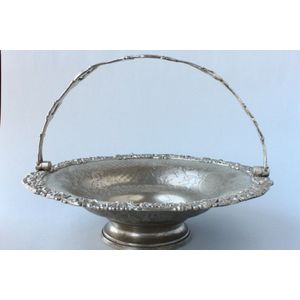Cooper Bros. Edwardian Silver Bread Basket with Floral Border
You must be a subscriber, and be logged in to view price and dealer details.
Subscribe Now to view actual auction price for this item
When you subscribe, you have the option of setting the currency in which to display prices to $Au, $US, $NZ or Stg.
- Edwardian - The Edwardian period of English furniture and decorative arts design is named for Edward VII (1841 ? 1910) who was King of the United Kingdom and the British Dominions and Emperor of India for the brief period from 1901 until his death in 1910. It follows the Victorian period, in turn was followed by the Art Nouveau and Art Deco styles. In Australia, designs of this period are also known as being in the Federation style.
- Chasing - The method of decorating gold and silver objects using a punch and hammer so that the design appears in relief. Flat or surface chasing is done from the front giving the item definition, but not cutting into the metal.
Chasing is the opposite technique to repousse, but an object that has repousse work, may then have chasing applied to create a finished piece. - Bread Basket - Bread baskets were commonly used from the 17th to the 19th centuries in Europe and America as a serving piece at formal meals. In the early 17th century, bread baskets were made of wood, pewter and later silver as it was an expensive and prestigious material and demonstrated off the host?s wealth and status.
These bread baskets were usually oval or circular in shape, and were typically decorated with intricate engravings, embossing, and other decorative details. Some were plain and simple, while others were quite ornate, featuring raised scrollwork, beading, or other decorative motifs. Those made in the early 17th century tend to have two handles but surviving examples are rare. From the mid 1770s they usually have a central swing handle. The handles were typically ornate and often curved or scrolled. The shape and size of these baskets varies; some are large, meant to hold multiple loaves, others are more compact and meant for one loaf. By the 18th century, most bread baskets were made of silver. - Sterling Silver - Sterling silver is a mixture of 92.5% pure silver and 7.5% of another metal, usually copper. Fine silver is 99.9% pure silver, and is relatively soft and the addition of the very small amount of copper gives the metal enough strength and hardness to be worked into jewellery, decorative and household objects.
- Hallmarks - A mark stamped on articles of precious metals in Britain, since the 14th century, certifying their purity. It derives its name from the Guild Hall of the Goldsmiths' Company, who recieved its Charter in 1327 giving it the power to assay (test the purity) and mark articles of gold and silver.
The hallmark will consist of several marks, including the:
- silver standard mark, indicating the purity of the metal. Sterling silver is .925 pure silver.
- the city mark indicating the city in which it was assayed eg London, Birmingham, York etc.
- the date mark, usually a letter of the alphabet in a particular font and case,
- a duty mark, indicating whether duty had been paid to the crown, and only in use from 1784 to 1890
The piece may include an additional mark, the maker's mark, although not forming part of the hallmark, will be located in the vicinity of the hallmarks.
Sometimes silver plated items will bear faux hallmarks, often confusing those not familiar with silver markings.
This item has been included into following indexes:
Visually similar items

A George III silver cake basket by Robert Hennell, London 1782, of neoclassical design with pierced, engraved and bright cut detailing, engraved with crest to well, 36.5 cm wide, 739 grams

Late Victorian silver plate fruit basket, of circular form decorated with flowers and foliage, swing handle, of circular foot, a/f, diameter 32 cm

Sterling silver cake basket, mark of S. Blanckensee & Son Ltd., Chester, 1909, reeded swing handle, sides with reticulated decoration, together with a Victorian sterling silver comport with gilded interior, and a 1920s sterling silver comport, all hallmark

English hallmarked sterling silver swing handle open salt with a blue glass liner. Birmingham, 1904, maker William hair Haseler. Length 13 cm weight 111g
